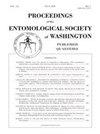Newly Documented Life History of Tenthredo mellicoxa Provancher (Hymenoptera: Tenthredinidae) from Hydrophyllum virginianum L. (Boraginaceae)
IF 0.4
4区 农林科学
Q4 ENTOMOLOGY
Proceedings of the Entomological Society of Washington
Pub Date : 2023-07-14
DOI:10.4289/0013-8797.124.4.884
引用次数: 0
Abstract
the most species-rich genus of Symphyta (sawflies) with more than 1000 described species worldwide—roughly 154 of these found in the Nearctic Region (Taeger et al. 2018, Goulet 2020). Despite their larger body size relative to many sawflies, surprisingly little is known of the biology of this genus in North America—we estimate the life histories of greater than 90 percent remain unknown (Baine et al. 2019). Published host records are documented from a wide diversity of plant families, and while several species appear to be highly specialized, many Palearctic Tenthredo are considered to be mainly polyphagous (Goulet 1996). Herein, we reveal for the first time the life history of T. mellicoxa Provancher, 1878 (Fig. 2) from Virginia waterleaf (Hydrophyllum virginianum L.) (Boraginaceae). As the first member of the T. rufopectus species group with a known life history, we hope this discovery will offer clues to the biology of related Tenthredo species, i.e., T. rufopectus (Norton, 1860), T. nimbipennis Cresson, 1872, T. ruma MacGillivray, 1923, and T. fernowi Goulet and Smith, 1995. As T. mellicoxa appears to be a Hydrophyllum specialist, we predict its kin may also be dietary specialists. In late April 2022, in Brown Co., Kansas (Hamlin, No-man’s Land Farm, (39.90625° lat, -95.58656° long)), TAM observed an abundance of adult T. mellicoxa flying around a large stand of Virginia waterleaf in a mesic, mixed deciduous forest (Fig. 1). Where the adults were abundant, Hydrophyllum, just shy of blooming, stood about 0.5 m tall and was the dominant understory plant. Adult Tenthredo (Fig. 2) were readily collected with a sweep net as they skimmed low above the waterleaf or as they perched on the upper surface of waterleaf leaves. TAM netted four adult females and placed them into separate 50-dram vials, each bearing a single Hydrophyllum leaf. All four females successfully oviposited. Observed details of the life history are as follows. Ova were inserted between the lower epidermis and mesophyll in nonvascular areas of the waterleaf leaf tissue (Fig. 3). The captive oviposition rate was remarkably consistent across the four captured females; each laid 12–15 eggs, with oviposition slowing 48 hours post collection and ceasing altogether 72 hours post collection. Eggs hatched 9–10 days post oviposition and first instar larvae immediately began feeding solitarily within the interior of the leaf blade leaving ovate holes behind (Fig. 4). The cloudy white bloom of early instars was replaced by the characteristic gray dorsum of later instars in the third instar. Like other Tenthredo and related genera, when not actively feeding larvae often coiled themselves on the undersides of the leaves, and when disturbed, would drop from the leaf surface. The fifth, prepupal instar did not form a silken cocoon, but rather was found to shelter in an earthen cell, presumably overwintering until pupation and subsequent eclosion the following spring. The average time from oviposition to prepupa was 21 days. The description of the immature stages of Tenthredo mellicoxa are as follows: Ova PROC. ENTOMOL. SOC. WASH. 124(4), 2022, pp. 884–888原产于水草科(水草科)的绒螯蛛生活史新记录(膜翅目:绒螯蛛科)
Symphyta属(锯蝇)是物种最丰富的属,在全球范围内有1000多个物种,其中大约154个在近北地区发现(Taeger等人,2018,Goulet 2020)。尽管相对于许多锯蝇来说,它们的体型更大,但令人惊讶的是,人们对北美该属的生物学知之甚少——我们估计,90%以上的人的生活史仍然未知(Baine等人,2019)。已发表的寄主记录来自广泛多样的植物科,虽然有几个物种似乎是高度特化的,但许多古北极帐篷被认为主要是多食性的(Goulet 1996)。在此,我们首次揭示了T.mellicoxa Provancher的生活史,1878年(图2),来自弗吉尼亚睡莲(Hydrophyllum virginianum L.)(紫草科)。作为第一个有已知生活史的T.rufopectus物种群成员,我们希望这一发现能为相关Tentredo物种的生物学提供线索,即T.rufospectus(Norton,1860)、T.nimbipennis Cresson,1872、T.ruma MacGillivray,1923以及T.fernowi Goulet和Smith,1995。由于T.mellicoxa似乎是水生植物专家,我们预测它的亲属也可能是饮食专家。2022年4月下旬,在堪萨斯州布朗公司(哈姆林,无人区农场,(39.90625°纬度,-95.558656°长),TAM观察到大量的成年甜叶T.mellicoxa在一片混合落叶林中的弗吉尼亚州大片睡叶周围飞行(图1)。在成虫丰富的地方,水生植物几乎没有开花,高约0.5米,是林下的主要植物。成年Tentredo(图2)在吃水线以上低空掠过或栖息在吃水线叶片上表面时,很容易用清扫网收集。TAM捕获了四只成年雌性,并将它们分别放入50德拉姆的小瓶中,每个小瓶上都有一片水生植物叶子。四只雌性都成功产卵。观察到的生活史细节如下。卵被插入在无水叶叶组织的无血管区域的下表皮和叶肉之间(图3)。四只被捕获的雌性的圈养产卵率非常一致;每只产卵12-15枚,产卵速度在采集后48小时减慢,采集后72小时停止。产卵后9-10天孵化的卵,一龄幼虫立即开始在叶片内部单独进食,留下卵孔(图4)。初龄的云白色花朵在三龄时被晚龄的特征性灰背所取代。与其他Tentredo属和相关属一样,当幼虫不积极进食时,它们经常盘绕在叶子的下侧,当受到干扰时,它们会从叶子表面掉下来。第五龄,即蛹前龄,并没有形成蚕茧,而是被发现躲在土细胞中,可能会越冬,直到化蛹,然后在第二年春天羽化。从产卵到预产卵的平均时间为21天。对蜜桃未成熟阶段的描述如下:Ova PROC。昆虫学。SOC。WASH.124(4),2022,第884-888页
本文章由计算机程序翻译,如有差异,请以英文原文为准。
求助全文
约1分钟内获得全文
求助全文
来源期刊
CiteScore
0.90
自引率
16.70%
发文量
40
审稿时长
>12 weeks
期刊介绍:
The Proceedings of the Entomological Society of Washington is published four times a year in January, April, July, and October. The journal publishes on all aspects of original research in entomology. Subject matter includes systematics, taxonomy, biology, behavior, ecology, morphology, genetics, and other topics.

 求助内容:
求助内容: 应助结果提醒方式:
应助结果提醒方式:


